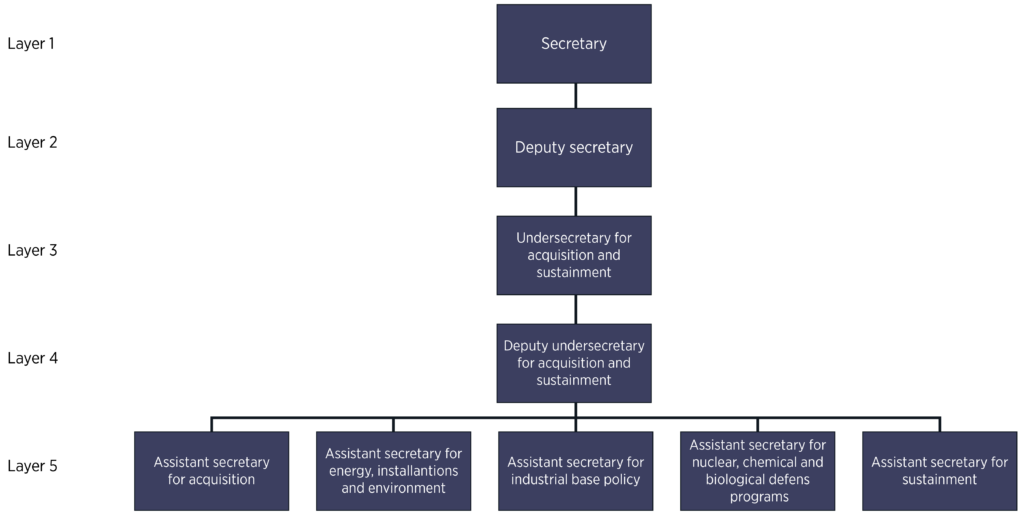
To understand the growing layers of government management, it is helpful to look at an example of the hierarchical leadership structure of Cabinet departments. For instance, in the Department of Defense, it is common for a bureau or office to have as many as five levels of Senate-confirmed political appointees. Below is an example of the organizational structure that falls under the undersecretary of Defense for acquisition and sustainment, the individual in charge of ensuring the quick and cost-effective delivery and sustainment of secure, resilient and preeminent capabilities to Department of Defense personnel and international partners. The seven offices or bureaus overseen by the assistant secretary for acquisition are also supervised by the deputy undersecretary for acquisition and sustainment, the undersecretary for acquisition and sustainment, the deputy secretary and the secretary.
Example of Layering in the Department of Defense

Layering in Cabinet Departments
The Department of Defense is the largest federal agency and has the most levels in its chain of command of any Cabinet department, with five layers of Senate-confirmed political appointees. The fifth level is comprised of 17 assistant secretaries and directors who report to a deputy undersecretary. The Department of Defense has even more complexity when considering the Senate-confirmed positions at the Departments of the Air Force, Army and Navy. However, since those departments are often thought of as separate entities within the Department of Defense, they are not included in this analysis.
The other four Cabinet departments with the most layering, Commerce, Energy, State and Treasury, have four levels of Senate-confirmed political appointees. The Department of State has the largest number of Senate-confirmed positions among the group, with 26 Senate-confirmed officials at the fourth level, excluding ambassadors. In these departments, the fourth level of officials are overseen by an undersecretary.
Number of Senate-confirmed Positions in Each Layer for Five Cabinet Departments with the Most Layering
| Department |
Layer 1 |
Layer 2 |
Layer 3 |
Layer 4 |
Layer 5 |
Total |
| State (excludes ambassadors) |
1 |
2 |
10 |
26 |
0 |
39 |
| Defense |
1 |
1 |
10 |
6 |
17 |
35 |
| Energy |
1 |
1 |
12 |
9 |
0 |
23 |
| Commerce |
1 |
1 |
12 |
8 |
0 |
22 |
| Treasury |
1 |
1 |
11 |
9 |
0 |
22 |





